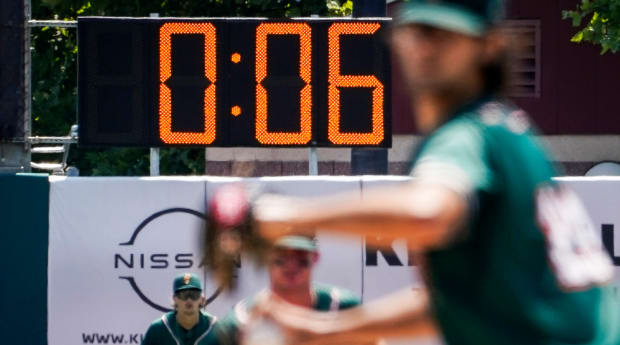
AP Photo/John Minchillo
Regular readers of this newsletter know I disagree with Rob Manfred frequently. His handling of MLB labor issues is callous, and at best, he is an awkward public speaker. His treatment of minor leaguers is inhumane, and he has mishandled multiple baseball cheating scandals.
For all of these reasons, he bears the brunt of our criticism for most of baseball’s problems. He’s an easy target for our frustrations, and many times he deserves it. Still, he is not solely to blame for all that’s wrong with our game. Indeed, he did not create most of these woes; rather, they are systemic. Oftentimes, our gripe is he is exacerbating these issues instead of alleviating them.
That cannot be said for his efforts to improve baseball’s pace of play. Today, MLB’s Competition Committee voted to approve sweeping rule changes for next season that include restricting defensive shifts, implementing a pitch timer and using bigger bases.
Naturally, as is the case with anything involving negotiations between MLB and the MLBPA, there were some major disagreements. The four current players on the Competition Committee unanimously voted against the shift rules and the pitch timer. In a statement, the MLBPA said, “Player leaders from across the league were engaged in on-field rules negotiations through the Competition Committee, and they provided specific and actionable feedback on the changes proposed by the Commissioner’s Office. Major League Baseball was unwilling to meaningfully address the areas of concern that layers raised, and as a result, Players on the Competition Committee voted unanimously against the implementation of the rules covering defensive shifts and the use of a pitch timer.” MLB was still able to pass these rule changes because of the lack of balance on the Competition Committee, which, in addition to the four current players, includes six members appointed by MLB and one umpire.
Manfred’s tenure as commissioner has been defined by the lack of trust between the league and the players, and based on the MLBPA’s statement and the results of the vote, the gulf between the two sides clearly hasn’t narrowed much. This will continue to be a problem going forward.
Right now, we don’t know what “specific and actionable feedback” the players gave MLB, so we can’t make any definitive conclusions about whether these are the optimal rule changes for baseball. But we can evaluate them based on their own merits, and, for the most part, they should achieve their purpose of creating a more active game and cutting down on dead time.
Let’s take a deeper look at the three main changes and what they could mean for baseball.
1) Restrictions for defensive shifts
Not counting the pitcher and catcher, four players must have both of their feet on the infield dirt when the pitcher releases the ball, and two infielders must be on each side of second base. The teams must designate before the game which players will stand on each side. Those players will not be allowed to switch sides during the game, unless there’s a substitution.
For example, teams cannot flip the shortstop and second baseman depending on which opposing batter is at the plate.
Fielding teams are charged with an automatic ball for violating this rule, unless the pitch results in the batter reaching base safely without an out being recorded. If an out is recorded in a way that benefits the hitting team—such as a sacrifice bunt, sacrifice fly, fielder’s choice, etc.—that team’s manager has the choice to accept the outcome of the play or take an automatic ball. Teams can challenge any shift ruling—either for compliance or violation.
2) Pitch timer
Pitchers will have 15 seconds to start their throwing motion with the bases empty, and 20 seconds with men on base. The catcher has to be in the catcher’s box with nine seconds left on the timer; the batter must be in the batter’s box and ready for the pitch with eight seconds remaining. An automatic ball is called if the pitcher or catcher violates the rule. An automatic strike is the batter’s penalty.
3) Bigger bases
The size of the bases will increase from 15 to 18 inches. The idea is to encourage more stolen bases and cut down on injuries around the bases. This was the only proposal that passed unanimously. It’s also the one that most fans won’t notice.
The Good
The pitch timer is the best of the three rule changes, because it keeps the flow of the game moving without sacrificing any of the action. Fans really don’t need to watch Giovanny Gallegos or Kenley Jansen take 25–30 seconds between pitches with nobody on base.
For the most part, the shift restrictions are a good thing. The purpose of limiting defensive alignment should be to reward batters for making solid contact. For example, line drives hit by lefties into right field should be singles, not 4–3 groundouts. Requiring teams to have four infielders at all times fixes that.
The Bad
That said, the bad part of the rule changes is that MLB is hoping the new defensive shift rules will fix baseball’s inaction problem. Those improvements will be marginal at best because shift regulations won’t do enough to curb the strikeout rate.
Shifts are only partly responsible for the drop-off of balls in play we’ve seen over the past decade. It’s true that batters are looking to hit the ball in the air because they can’t hit it through the shift, and therefore, they are willing to trade contact for power. But, the push for power has been around far longer than the shifting surge.
The biggest reason for all the strikeouts is that pitching staffs across the league are deeper and more dominant than ever before. Most bullpens have at least a handful of relievers with 100-mph heaters and nasty breaking balls who don’t have to worry about pacing themselves because as soon as they begin to fatigue, their manager will bring in the next guy. Missing bats is the top priority for most pitchers in the league, and they are really, really good at it. There might be a few more balls in play per game because of the shift restrictions, but there will still be way too many strikeouts.
The Meh
Next season, pitchers will be limited to two “disengagements” per plate appearance. A disengagement occurs any time a pitcher steps off the pitcher’s rubber, the most common reason for doing so is to attempt a pickoff. Effectively, this rule limits pitchers to two pickoff attempts during a plate appearance, with a few exceptions: If the pitcher steps off for any other reason, say, to wipe the sweat off his face after coming set, that counts as a disengagement. That would mean he’d have just one pickoff attempt during that plate appearance.
- If the pitcher steps off for any other reason, say, to wipe the sweat off his face after coming set, that counts as a disengagement. That would mean he’d have just one pickoff attempt during that plate appearance.
- If a base runner advances during the same plate appearance (via a stolen base, wild pitch, etc.), the pitcher gets two additional step-offs—i.e., two more pickoff attempts.
The penalty for stepping off three or more times during a plate appearance depends on the outcome of the disengagement.
- If the pitcher steps off but doesn’t throw over, it’s a balk and all runners advance to the next base.
- If the pitcher steps off and tries to pick off the runner, but the runner gets back safely, a balk is called and all runners advance.
- If the runner advances to the next base on a pickoff attempt or step-off, no balk is called because a runner already moved up.
- If a pitcher successfully picks off a runner on a throw over after two step-offs, the runner is out, and there is no penalty for the defense.
The benefit of this rule is it should encourage more stolen base attempts because if runners don’t have to worry about getting picked off, they can take bigger leads. The potential downside is too many stolen bases where the runner advances too easily. Stolen bases are great for baseball because they create bursts of action, but part of the excitement is not knowing when the runner takes off whether he will be safe or out.
Sure, if the runner takes an egregiously large lead after two pickoff attempts, the pitcher probably will throw over for a third time with no penalty, either because he will pick off the runner or because the runner will steal the base. But, knowing how risk averse baseball has become, pitchers probably won’t throw over for a third time unless they know they have the runner dead to rights. It’s just not worth risking a balk over it.
Have any questions for our team? Send a note to mlb@si.com.
1. THE OPENER
“For nearly two decades baseball games have been getting longer with less action. Baseball finally is taking meaningful steps not just to end the trend but also reverse it: more action in less time.”
That’s how Tom Verducci begins his column about the rule changes. In an easy-to-read, Q&A format, Tom lays out why these new rules are necessary and how they will improve the game.
You can read his entire story here.
Everything You Need to Know About MLB’s Rule Changes by Tom Verducci
2. ICYMI
Let’s run through some of our other great SI baseball stories from this week.
MLB’s Most Traded Player Is Happy to Be Back Home by Emma Baccellieri
Jesse Chavez has been dealt 10 times in his career. Now, he’s back with Atlanta for a fourth stint (and second time this season), thrilled to be in a comfortable environment.
Christian Yelich’s Moon Shot Reminds the Brewers of What They’re Missing by Will Laws
Milwaukee’s playoff hopes will depend on whether its face-of-the-franchise slugger starts slugging again.
Never Count Out the Rays. And Always Keep Your Mouth Shut by Nick Selbe
Less than two months ago, Tampa Bay looked destined for a free fall. Instead, this shape-shifting organization proved yet again that it is unwise to doubt it.
Jacob deGrom Is Reaching a Whole New Level of deGrominance by Tom Verducci
He makes the Mets a dangerous playoff team, but his supremacy comes with a trade-off. That’s why it’s imperative they hold on to first place in the NL East.
3. WORTH NOTING from Tom Verducci

Joe Rondone/Arizona Republic/USA TODAY Sports Network
Aaron Judge isn’t the only player chasing a hallowed record this month. Entering a start Monday in Colorado, Diamondbacks pitcher Zac Gallen has thrown 41 1/3 consecutive scoreless innings. The record is 59 straight scoreless innings by Orel Hershiser. Gallen (Bishop Eustace) and Hershiser (Cherry Hill East) attended high schools eight miles apart in New Jersey in the suburbs of Philadelphia.
Under pitching coach Brent Strom, and with a refined delivery in which he tucks his leg more underneath him, Gallen, 27, has elevated his game to the next level. Strom remembered how the Astros’ analytics crew liked Gallen so much they told Strom, “If you don’t get this guy to win a Cy Young Award, something’s wrong.”
Strom calls Gallen “the most detailed pitcher I ever have been around.” High praise from someone who has worked with Justin Verlander, Gerrit Cole and Zack Greinke.
Gallen throws five pitches: four-seamer, cutter, slider, curve and change. His command and sequencing are so good that the righthander has held lefties to a .150 batting average, which is tied with Pedro Martínez in 2000 for the lowest single-season average for a right-handed pitcher vs. lefty batters in the Live Ball era (minimum of 100 innings pitched). Lefties are hitting .099 against Gallen’s four-seamer.
Gallen is just two outs away from Brandon Webb’s franchise record for consecutive scoreless innings. Under Gallen, and with a bevy of interesting young outfielders, the Diamondbacks, losers of 110 games last year, have become a fun watch in September.
4. W2W4 from Nick Selbe
We’ve already seen one New York team squander its sizable division lead. Are we about to see another? The Yankees enter the weekend 4.5 games clear of the streaking Rays, and Tampa Bay arrives in the Bronx for a three-game set. The Rays are 4–2 against the Yankees in the second half, and this is the final time these two will meet up. Since the All-Star break, the Yankees are hitting .222 as a team despite Aaron Judge continuing his historic performance at the plate. In 45 games since the All-Star break, Judge is batting .342/.493/.826 with 22 home runs and eight stolen bases.
Elsewhere, the Guardians head to Minnesota for a crucial three-game series with the AL Central hanging in the balance. Cleveland holds a 1.5-game lead on both the Twins and White Sox, who are currently taking on the last-place A’s. The AL Central has clearly been the weakest division of the six, but at least it’s setting up to provide an exciting photo finish with a narrow three-horse race.
5. THE CLOSER from Emma Baccellieri
My favorite thing I saw this week was Yadier Molina and Adam Wainwright’s record-tying 324th start as a battery. It’s a kind of feat we’re unlikely to see again—requiring not just the continued health and success of both players but the confluence of willingness and luck that can put both on the same team for their whole careers. There’s something very comforting about being able to watch the Cardinals’ pair work like this as an institution in their own right. (Especially so when the pitcher is as capable as this one: Wainwright, who turned 41 last week, has a 115 ERA+ and is tied for the major league lead in games started. At 41!) And for them to do it on the same team where 42-year-old Albert Pujols is chasing home run No. 700? What a joy.







